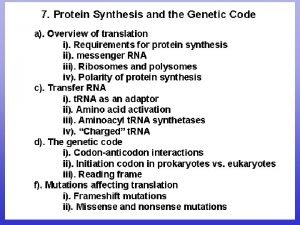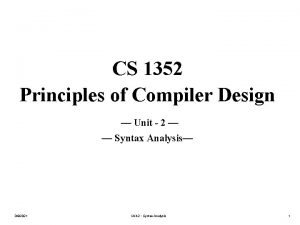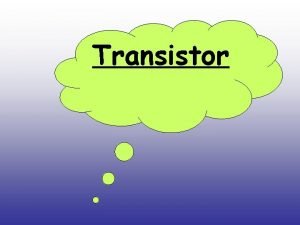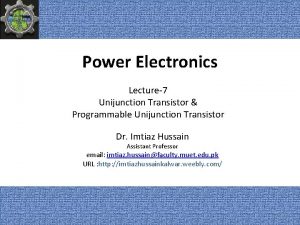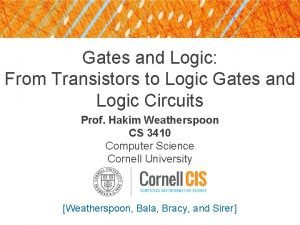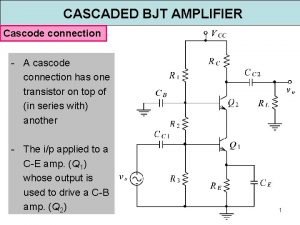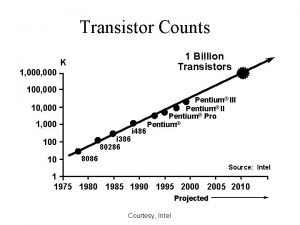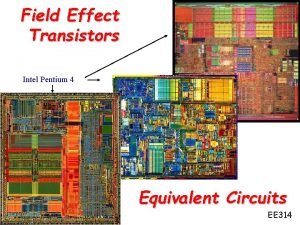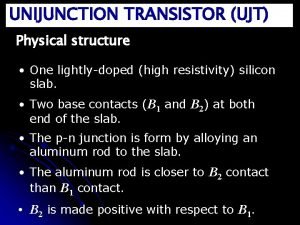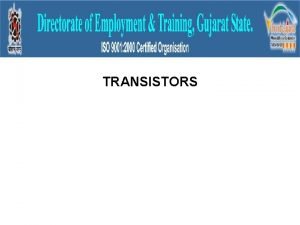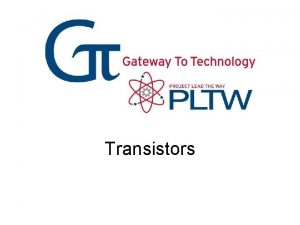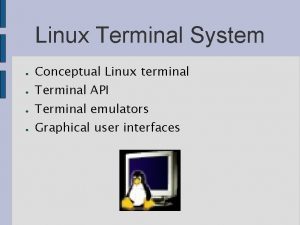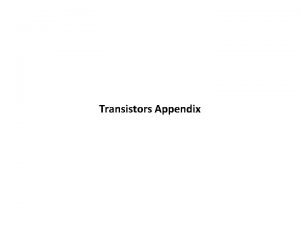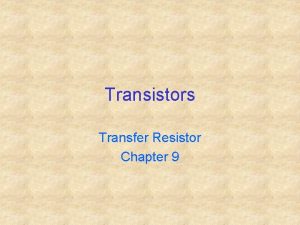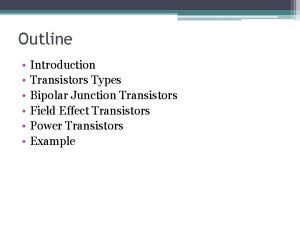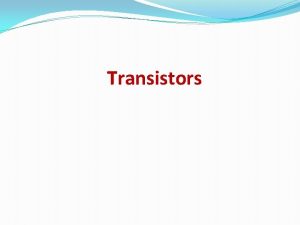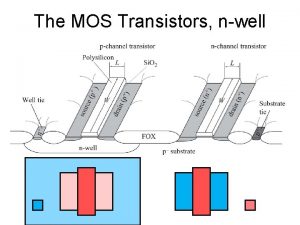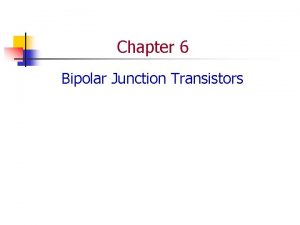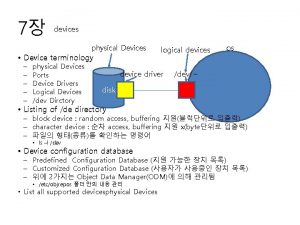Transistors These are three terminal devices where the



















































- Slides: 51

Transistors These are three terminal devices, where the current or voltage at one terminal, the input terminal, controls the flow of current between the two remaining terminals.

Transistors Can be classified as: n FET – Field Effect Transistor; w Majority carrier device; w Unipolar device; n BJT – Bipolar Junction Transistor; w Minority carrier device; w Bipolar device.

FETs Two primary types: n n MOSFET, Metal-Oxide-Semiconductor FET. Also known as IGFET – Insulated Gate FET; JFET, Junction FET. MOS transistors can be: n n n-Channel; w Enhancement mode; w Depletion mode; p-Channel; w Enhancement mode; w Depletion mode;

MOSFET Structure

MOSFETs are identified by symbols like the ones shown below:

MOSFET Operation Voltage at gate controls the flow of current between drain and source. VGS – Voltage between gate and source. VDS – Voltage between drain and source.

MOSFET Operation When VGS = 0 then no current flows between drain and source. pn-Junction is reverse biased.

Threshold Voltage The value of VGS where the drain current just begins to flow. Typical values: n 0. 3 to 0. 8 volts.

MOSFET Operation Two cases: n Ohmic region: n Active Region:

MOSFET Operation Ohmic Region:

MOSFET Operation Active Region:

K Parameter The constant K, called the conductance parameter, is measured in units of m. A/V 2. n Where:

MOSFET Output Curves A family of curves representing the V-I characteristics of transistors. A plot of drain current, ID, as a function of drain-tosource voltage, VDS, for several values of VGS.

Ohmic and Active Regions

P-Channel Enhancement MOSFET Note the n-type body and the p-type source and drain areas. Both VGS and VDD are negative with respect to ground.

Depletion Mode MOSFETs n-Channel is built in. VGS varies from negative values to positive values, where negative values of VGS depletes the channel while positive values enhance it further.

JFETs Depletion-mode FET with a different structure than that of the MOSFET. Not generally used for switching elements of digital circuits. Used in special applications such as analog circuits where very high input impedance is required.

JFETs Every p-n junction has a depletion region devoid of carriers, and the width of the depletion region can be controlled by the applied voltage across the junction.

JFETs Note the highest value of VGS. What happens if you make VGS positive with respect to ground.

Inverter Circuit This circuit is designated as the common source configuration. It is used in digital circuits.

Inverter Circuit When Vin is low the transistor is off and Vout is high. When Vin is high the transistor is on and Vout is low.

MOSFET Circuit Model For Switching VGS controls the switch in the model and ron is defined as:

Inverter Circuit

Inverter Circuit For RL = 1 KΩ, and VDD=5 V.

Large Signal Amplifiers DC biasing: n n n Ensuring that the transistor has the correct dc level at its terminals. Termed as setting the Q-point, quiescent operating bias point. Same as setting the dc voltages and currents for the circuit with no signal applied.

Large Signal Amplifiers The dc bias voltages and currents must be maintained even when the circuit is confronted with: n n n Sources variations; Temperature changes; Change in component values due to manufacturing process inconsistencies.

Common Source Amplifier

Common Source Amplifier

Self-Bias Circuit Useful for devices that require a negative gate-to-source voltage (depletion mode n-channel devices). Negative gate-to-source voltages are achieved by raising the source voltage higher than the gate voltage.

Self-Bias Circuit

Self-Bias Circuit

Procedure Draw load line on the output curves of the transistor. Locate the Q-point on the load line. If there is a bypass capacitor in the circuit, then construct an ac load line with slope: Calculate the large signal voltage gain.

Other FET Configurations

BJTs Invented in 1947 in the Bell Laboratories. It revolutionized electronics, by replacing the vacuum tubes. Standard for the TTL (Transistor-Logic) and ECL (Emitter. Coupled-Logic) families of logic devices.

BJT Structure Three-layer sandwich of alternating semiconductor materials. Two types: n n NPN; PNP. Terminals: n n n Emitter; Base; Collector.

BJT Structure Two p –n junction diodes built very close together. The junction between base and emitter is called emitter junction, and the junction between base and collector is called collector junction.

BJT Structure The emitter is placed on top of the collector with a very thin base between them, and the primary carrier flow is from the emitter to the collector.

Modes of Operation Cutoff – Both junctions are reverse biased and the transistor appears as an open switch. Saturation – Both junctions are forward biased and the transistor appears as a closed switch. These two bias conditions are important for digital circuits.

BJT Working as a Switch Note the simplified interpretation of the BJT working as a switch in cutoff and saturation.

BJT Models for Switching IB(SAT) - the minimum base current to be exceeded for the transistor to be considered in saturation mode.

Modes of Operation Active – The emitter junction is forward biased and the collector junction is reverse biased. Reverse active – The emitter junction is reverse biased and the collector junction is forward biased.

Active Region

Active Region

Ebers-Moll Model

Ebers-Moll Model

Common Emitter Amplifier

Common Source Amplifier Non-linear. Large variations in beta. Thermal runaway.

Self-Bias Circuit Useful to control the effects discussed in the previous slide. This circuit stabilizes collector current instead of base current, thus reducing the effects of beta variations and temperature on the quiescent operating point. Collector current is determined by the voltage across a resistor, RE, placed in series with the emitter.

Self-Bias Circuit

Procedure Draw load line on the output curves of the transistor. Locate the Q-point on the load line. If there is a bypass capacitor in the circuit, then construct an ac load line with slope: Calculate the large signal voltage gain.

Other BJT Configurations
 Mikael ferm
Mikael ferm Three terminal devices
Three terminal devices N-terminal c terminal 5 3
N-terminal c terminal 5 3 Terminal and non terminal in compiler design
Terminal and non terminal in compiler design Npn
Npn Ujt applications
Ujt applications Application du transistor
Application du transistor Logic gates using transistors
Logic gates using transistors Cascode bjt amplifier
Cascode bjt amplifier 8086 transistor count
8086 transistor count Two steps
Two steps Physical structure of transistor
Physical structure of transistor Kilo mega giga tera peta
Kilo mega giga tera peta Transistors were used in which generation of computers
Transistors were used in which generation of computers Today nanotechnology produced computer transistors
Today nanotechnology produced computer transistors Hình ảnh bộ gõ cơ thể búng tay
Hình ảnh bộ gõ cơ thể búng tay Slidetodoc
Slidetodoc Bổ thể
Bổ thể Tỉ lệ cơ thể trẻ em
Tỉ lệ cơ thể trẻ em Gấu đi như thế nào
Gấu đi như thế nào Tư thế worm breton là gì
Tư thế worm breton là gì Chúa sống lại
Chúa sống lại Các môn thể thao bắt đầu bằng tiếng bóng
Các môn thể thao bắt đầu bằng tiếng bóng Thế nào là hệ số cao nhất
Thế nào là hệ số cao nhất Các châu lục và đại dương trên thế giới
Các châu lục và đại dương trên thế giới Công thức tính thế năng
Công thức tính thế năng Trời xanh đây là của chúng ta thể thơ
Trời xanh đây là của chúng ta thể thơ Cách giải mật thư tọa độ
Cách giải mật thư tọa độ Phép trừ bù
Phép trừ bù Phản ứng thế ankan
Phản ứng thế ankan Các châu lục và đại dương trên thế giới
Các châu lục và đại dương trên thế giới Thể thơ truyền thống
Thể thơ truyền thống Quá trình desamine hóa có thể tạo ra
Quá trình desamine hóa có thể tạo ra Một số thể thơ truyền thống
Một số thể thơ truyền thống Bàn tay mà dây bẩn
Bàn tay mà dây bẩn Vẽ hình chiếu vuông góc của vật thể sau
Vẽ hình chiếu vuông góc của vật thể sau Thế nào là sự mỏi cơ
Thế nào là sự mỏi cơ đặc điểm cơ thể của người tối cổ
đặc điểm cơ thể của người tối cổ V. c c
V. c c Vẽ hình chiếu đứng bằng cạnh của vật thể
Vẽ hình chiếu đứng bằng cạnh của vật thể Tia chieu sa te
Tia chieu sa te Thẻ vin
Thẻ vin đại từ thay thế
đại từ thay thế điện thế nghỉ
điện thế nghỉ Tư thế ngồi viết
Tư thế ngồi viết Diễn thế sinh thái là
Diễn thế sinh thái là Dạng đột biến một nhiễm là
Dạng đột biến một nhiễm là Các số nguyên tố là gì
Các số nguyên tố là gì Tư thế ngồi viết
Tư thế ngồi viết Lời thề hippocrates
Lời thề hippocrates Thiếu nhi thế giới liên hoan
Thiếu nhi thế giới liên hoan ưu thế lai là gì
ưu thế lai là gì


